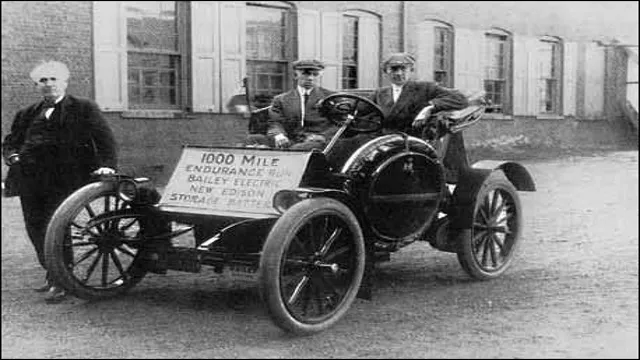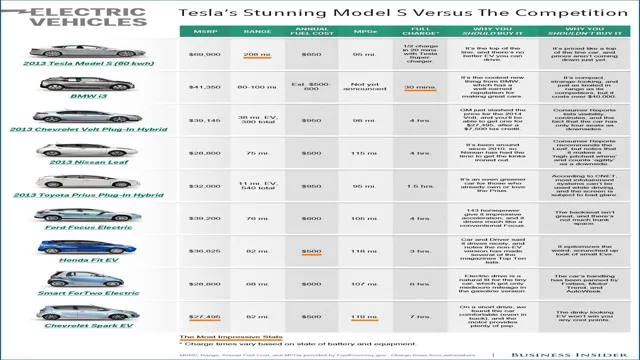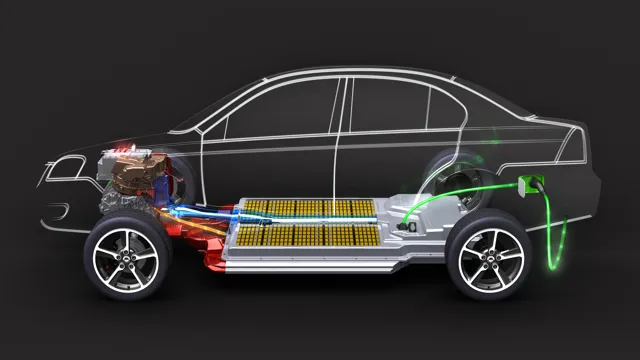Revolutionizing EV Charging: Exploring China’s Rapidly Growing Electric Car Battery Swapping Stations
If you’ve ever driven an electric car, you know how nerve-wracking it can be to watch the battery level go down when you’re nowhere near a charging station. But what if I told you that China has been tackling this problem in a unique way – with battery-swapping stations? These stations allow electric vehicle (EV) owners to simply exchange their depleted battery for a fully charged one in as little as three minutes. This concept may sound strange to those of us accustomed to traditional gas stations, but it’s a promising solution to the issue of range anxiety for EV drivers.
So, how do these battery-swapping stations work? And is this technology something that could be implemented in other countries? Let’s dive in and find out.
Introduction
China is pioneering a new way of powering electric cars by building battery swapping stations. This innovative concept allows drivers to exchange their depleted batteries with fully charged ones in a matter of minutes. The infrastructure for battery swapping stations is rapidly expanding in China, with more than 800 operating nationwide.
This trend is expected to revolutionize the electric car industry and make it more appealing to consumers who have been concerned about the limited range of these vehicles. The battery swapping technology not only extends range but also eliminates the need for charging stations, making it more convenient for drivers to switch batteries on-the-go. Additionally, this technology will aid in reducing the environmental impact of transportation by promoting the use of renewable energy sources and reducing greenhouse gas emissions.
The battery swapping stations are definitely a game-changer for the electric car industry in China and one that will pave the way for a greener, cleaner, and sustainable future.
Growing Popularity of Electric Cars in China
The growing popularity of electric cars in China is a topic that has been making rounds in recent years. One reason for this trend is the push towards cleaner air and a reduction in carbon emissions. China has long been grappling with environmental challenges, and electric cars provide a promising solution.
Another factor driving the adoption of electric cars is the expanding middle class. With more disposable income, people are increasingly turning to electric cars as a status symbol. Furthermore, the Chinese government incentivizes the purchase of electric cars by offering significant subsidies, tax breaks, and free license plates.
All these efforts are aimed at making electric cars a more affordable and viable option for the masses. As a result, many automobile manufacturers are investing heavily in the production of electric cars to meet the rising demand. It’s not surprising that China has become the world’s largest market for electric cars, and this trend is expected to continue in the future.

Challenges with Recharging Electric Cars
Electric Cars Recharging Challenges Driving an electric car is slowly becoming a popular trend due to its positive impact on the environment. However, recharging electric cars poses a significant challenge for owners. Electric car owners may find recharging their vehicles to be more time-consuming than refueling conventional vehicles, as current charging systems require a minimum of 30 minutes to charge the vehicle’s battery fully.
Charging stations are not as widely available as conventional fueling stations, and long lines may form at crowded charging stations during the peak hours. Additionally, the recharging process may be impeded in colder temperatures, as the battery’s chemical reactions may not take place efficiently. To overcome these challenges, developers and manufacturers are investing in technology improvements, and the establishment of more charging stations across the country.
The Solution: Battery Swapping Stations
China has been making great strides in promoting the use of electric vehicles, and one solution to the limited range of these cars is battery swapping stations. These stations allow drivers to quickly exchange a depleted battery for a fully charged one, which can take as little as three minutes. This is especially useful for those who have longer commutes or frequently travel intercity.
China has been proactive in building out a network of battery swapping stations and now has over 500 of them throughout the country. Battery swapping is a convenient solution for drivers and also reduces the amount of time needed to charge a vehicle. As battery technology continues to evolve, it’s possible that this method of recharging could become even faster and more efficient.
With the growth of electric vehicles, it’s clear that battery swapping stations will play a critical role in the development of the industry and the continued reduction of greenhouse gas emissions.
How Battery Swapping Stations Work
Battery swapping stations can offer a convenient and efficient solution for electric vehicle (EV) owners. Rather than waiting for hours to charge a depleted battery, drivers can simply swap out their empty battery for a fully charged one in a matter of minutes. These stations work by storing a large number of charged batteries on site, and when a driver arrives to swap their battery, a robotic system removes the depleted battery and replaces it with a fully charged one.
The process is quick and easy, and means there is no need for EV owners to worry about range anxiety or lengthy charging times. This innovative approach is gaining in popularity, with companies such as Tesla and Nio investing in battery swapping infrastructure to support their growing fleets of electric vehicles. By embracing this technology, we can make the switch to electric vehicles even more appealing and accessible, and help to transition towards a more sustainable future.
Current Availability of Battery Swapping Stations in China
One of the biggest challenges with electric vehicles has been finding a way to quickly recharge the battery. This is where battery swapping stations come in. In China, there has been a significant investment in building out a network of battery swapping stations to help alleviate range anxiety for EV drivers.
As of August 2021, there were over 2,700 battery swapping stations deployed across China, making it the largest network of its kind in the world. These stations allow drivers to quickly swap out a depleted battery for a fully charged one in a matter of minutes, providing a fast and convenient way to keep driving. While still not as widespread as traditional charging stations, battery swapping offers a promising solution to the problem of limited EV range, especially for heavy-duty applications like trucks and buses.
As more stations are deployed and battery technology continues to improve, this technology is likely to become an increasingly important part of the EV landscape.
Benefits of Using Battery Swapping Stations
Battery swapping stations offer a sustainable and efficient solution for EV drivers. With the increasing demand for electric vehicles, the issue of range anxiety and charging time has been a concern for many drivers. However, the battery swapping technology eliminates these concerns by providing an alternative to traditional charging methods.
Drivers simply need to visit a swapping station, which is similar to a gas station, and exchange their depleted battery with a fully charged one. This process takes just a few minutes and allows drivers to continue their journey without any delay. The benefits of using battery swapping stations include reduced charging time, increased convenience, and enhanced sustainability.
Moreover, this technology eliminates the need for expensive battery replacements and reduces the overall cost of operating electric vehicles. As a result, battery swapping stations are becoming increasingly popular and are expected to play a significant role in the future of sustainable transportation.
Future of Battery Swapping Stations in China
China has been a pioneering force in developing and implementing electric vehicle battery swapping stations. These stations offer an innovative solution for electric vehicle owners who may not have access to charging infrastructure or who don’t want to wait for their electric vehicle to charge. Instead, they can swap out their depleted battery for a fully charged one in just a few minutes.
Battery swapping stations are seen as an efficient and convenient means of providing charging solutions in China’s densely populated cities. China has also made significant investments in building up charging infrastructure across the country. With the government’s push towards electric vehicles, the market for battery swapping stations is expected to grow rapidly.
In the coming years, we can expect to see more battery swapping stations being set up in China to meet the growing demand for electric vehicles.
Plans for Expansion and Improvement
Battery swapping stations are becoming increasingly popular in China, and there are plans to expand and improve their services in the near future. The idea behind battery swapping stations is to allow electric vehicle drivers to simply swap out their empty battery for a fully charged one, rather than having to wait for their car to recharge. This has the potential to drastically reduce the time and inconvenience associated with EV charging.
Currently, battery swapping stations are primarily focused on serving commercial fleets in China, but there are plans to expand to serve individual customers as well. Additionally, there are plans to improve the speed and efficiency of the battery swapping process, as well as to incorporate more advanced technologies, such as AI and robotics, into the process. With these advancements and expansion plans, battery swapping stations are poised to play a major role in the future of EV transportation in China.
Potential Impact on the Automotive Industry
Battery swapping stations have been gaining momentum in China as a potential solution for reducing the environmental impact of traditional gasoline-powered vehicles. This trend has the potential to significantly impact the automotive industry, particularly in China where 400 battery swapping stations are planned to be built by 202 These stations will enable electric vehicle drivers to swap depleted batteries with fully charged ones, allowing them to continue their journey without having to wait for their battery to charge.
This technology has the potential to overcome one of the biggest hurdles of electric vehicles, which is their limited range. With battery swapping stations, electric vehicles could potentially travel long distances without the need for lengthy recharge times. This could lead to an increase of electric vehicles on the roads, which could impact the traditional gasoline-powered vehicles’ sales and cause a shift in the automotive industry.
Conclusion
In conclusion, China’s electric car battery swapping stations are revolutionizing the way we think about sustainable transportation. Like a well-oiled machine, these stations efficiently swap out depleted batteries for fully charged ones, allowing drivers to add range without the lengthy wait times associated with traditional charging. It’s a game changer that’s paving the way for a cleaner, more efficient future of mobility.
So buckle up and get ready to swap, swap, swap your way to a brighter tomorrow!”
FAQs
What is the concept behind electric car battery swapping stations in China?
Electric car battery swapping stations in China allow drivers to stop and exchange their depleted batteries for fully charged ones. This helps reduce charging time and eliminate the need for long charging cables and stations.
How many battery swapping stations are currently operating in China?
As of 2021, there are over 500 battery swapping stations in China that have been installed by various automakers and charging infrastructure companies.
What kind of batteries are used in electric cars at these swapping stations?
The batteries used for swapping in electric cars in China are standardized models, which range from 20 to 70 kWh in capacity. This allows for a wide range of compatible electric vehicles to participate in the battery swapping system.
Are there any disadvantages to using electric car battery swapping stations in China?
One disadvantage of using electric car battery swapping stations is that it requires a compatible battery from the vehicle manufacturer, which limits the selection of EV models that can use this system. Additionally, the battery swapping process is not yet as fast as filling up a petrol tank, though it is significantly quicker than charging via traditional methods.





